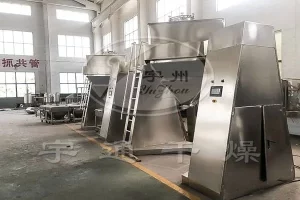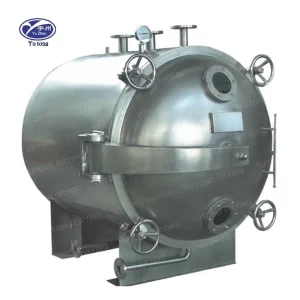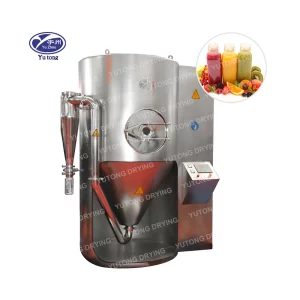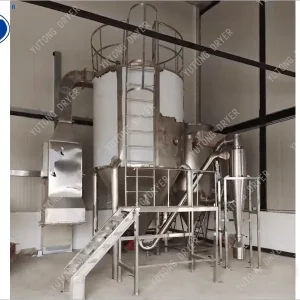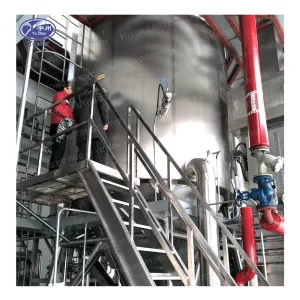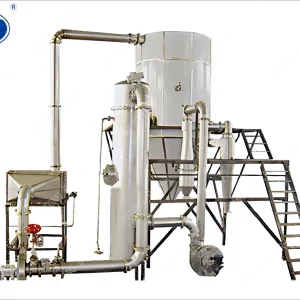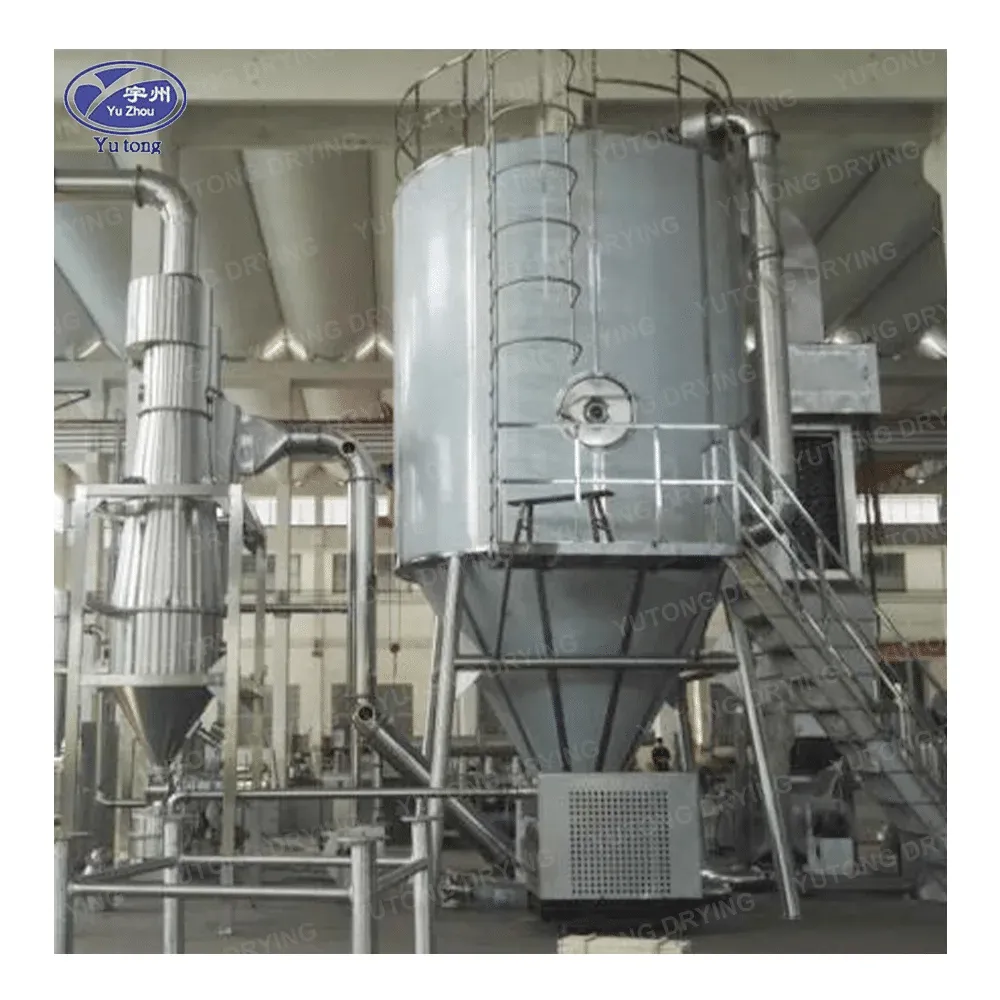Vacuum dryers are a multifaceted product used in a wide variety of processes in the food, chemical, pharmaceutical, and plastic industries. Vacuum dryers work to remove liquids from materials or to change a material’s molecular and physical chemistry. It removes liquid by heating the material through conduction and vaporizing the liquid. Vacuum dryers can change molecular and physical chemistry through chemical reactions and solid-state polymerization. These processes are thermal and do not involve mechanically separating the liquid from the material.
The vacuum drying system consists of a vacuum dryer, media heating and circulating, vacuum, and solvent recovery components. The dryer is the centerpiece of a vacuum and consists of an enclosed, thermal-jacketed vessel which is usually constructed of stainless steel. The hot media flows through the dryer’s circular jacket and transfers heat to the drying chamber. In a vacuum dryer, a vacuum line runs from the dryer to the source, usually a pump, which reduces the dryer’s atmospheric pressure. This line pulls off the vapors as they exit the dryer while the wet material dries. These vapors are then captured by a condensing system located between the vacuum source and dryer.
Vacuum drying can provide several benefits. Because vacuum drying controls atmospheric pressure, it reduces the boiling point required to remove the liquid. By controlling the pressure and reducing the boiling point, the material can be dried at a faster rate. This makes vacuum drying suitable for products that are heat sensitive. Hazardous materials are also suitable for vacuum drying. Dangerous chemicals or solvents are contained by the vacuum dryer without any threat to the outside atmosphere. Although vacuum drying can be quite beneficial, the heat transfer temperature is limited in comparison to direct-heat drying.
Vacuum dryers can offer two separate processes: batch and continuous. Most vacuum dryers operate under batch processing because of the dryer’s sealing requirements. Batch-processing is versatile and can be easily adapted to changing manufacturing processes. Vacuum dryers that operate under a continuous process can be made into a hybrid-batch-continuous process by installing additional equipment.
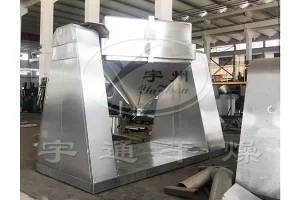
Processors have been searching for a more efficient vacuum dryer to better control their particle size and reduce the processing time. To answer these specific needs, Processall has developed the U-Max Dryer. The U-Max Dryer utilizes a mechanically fluidized bed mixing action complimented by the independent high-speed chopper/mills. The Processall mechanically fluidized bed principle is generated by the rotation of a shaft within the confines of a horizontal cylinder. Permanently affixed arms with plow-shaped agitating elements extend from this shaft. Material is constantly moving in axial and radial motion. The constant folding action is caused by the plow-shaped agitator elements with their overlapping paths. This assures constant mixing of material with each rotation. Each U-Max Dryer is designed for a specific Froude Number to maximize mixing and heat transfer efficiency.
The U-Max Dryer provides the customer with the following advantages:
- Reduced cycle time: Achieving a higher “U” factor to our Mechanical Fluidized Action complimented by the dryer’s chopper/mills reduces the cycle times.
- Particle size control: High-speed chopper/mills control the size of the particles and by utilizing the energy input the units provide the same particle size distribution batch after batch.
- Better temperature control: The dryer has a superior jacket design to control the heating media flow and eliminate hot or cold spots which combine with the Mechanical Fluidized Action to control the product temperature.
- Multi-step operations: Reaction, mixture, liquid dispersion, and granulation are just a few of the dryer’s capabilities.
- Reduced material handling: Processall handles multiple operations to reduce the number of times the product needs to be moved or conveyed.
- Moisture control: The Mechanical Fluidized Action and the particle size control of these dryers allow for manufacturers to receive the same percentage of moisture or solvent levels batch after batch.
Processall also maintains a fully equipped testing facility in Cincinnati, Ohio designed to provide customers with the data they need to develop their process, scale up to full production and identify the ideal Processall equipment and features to achieve the highest quality product at the desired production volumes. We extend an open invitation to all potential customers to bring their products to our test center and get a “hands-on” experience with our technology and capabilities.
We also maintain a rental fleet that customers can utilize to do further testing at their facility or employ to minimize their startup costs for a new process.
Contact us today with all your vacuum drying questions and our experienced industry professionals will help you find the right mixing solutions for your particular application.
Vacuum drying is a specialized drying process that offers several significant benefits across a wide range of industries. This method involves subjecting a material to a reduced pressure environment, which accelerates the removal of moisture and provides unique advantages compared to traditional drying methods.
One of the primary benefits of vacuum drying is the preservation of product quality. Since the drying occurs at lower temperatures compared to conventional methods, there is less risk of heat damage to heat-sensitive materials. This is particularly crucial in industries such as pharmaceuticals, where active ingredients can be degraded by high temperatures. In the food industry, vacuum drying can help retain the flavor, color, and nutritional value of delicate products like fruits, vegetables, and herbs. For example, vacuum-dried strawberries maintain their vibrant color and taste much better than those dried using traditional methods.
Another advantage of vacuum drying is the enhanced drying efficiency. The reduced pressure environment lowers the boiling point of water, allowing moisture to evaporate more quickly. This results in shorter drying times and increased productivity. Additionally, the lower pressure helps to remove moisture more thoroughly, as the vapor pressure differential between the material and the surrounding atmosphere is increased. This can lead to a more complete drying process and a lower final moisture content, which is important for many applications where moisture can cause spoilage, degradation, or reduced performance.
Vacuum drying also offers improved control over the drying process. The reduced pressure environment allows for more precise control of temperature and humidity, enabling operators to fine-tune the drying conditions to meet the specific requirements of the material being dried. This can result in a more consistent and reproducible drying process, which is essential for industries where quality control is critical. For instance, in the electronics industry, vacuum drying is used to remove moisture from sensitive components such as printed circuit boards and semiconductor devices. The precise control offered by vacuum drying helps to ensure that these components are dried evenly and without damage, improving their reliability and performance.
In addition to these benefits, vacuum drying can reduce energy consumption. Since the drying occurs at lower temperatures, less energy is required to heat the material. Additionally, the reduced pressure environment can help to reduce the amount of energy needed to remove moisture, as the vapor pressure differential is increased. This can lead to significant cost savings over time, especially for large-scale industrial applications.
Another advantage of vacuum drying is the ability to handle materials that are difficult to dry using conventional methods. Materials with high moisture content, viscous or sticky substances, and materials that are prone to oxidation or degradation can be effectively dried using vacuum drying. The reduced pressure environment helps to prevent oxidation and degradation, while also facilitating the removal of moisture from these challenging materials. For example, in the cosmetics industry, vacuum drying is used to dry delicate emulsions and gels without causing separation or degradation.
Finally, vacuum drying can offer improved safety compared to some other drying methods. Since the drying occurs at lower temperatures and in a controlled environment, there is less risk of fire or explosion. Additionally, the reduced pressure environment can help to prevent the release of harmful vapors or dust, reducing the risk of exposure to hazardous substances.
In conclusion, vacuum drying offers a wide range of benefits, including preservation of product quality, enhanced drying efficiency, improved process control, reduced energy consumption, the ability to handle difficult materials, and improved safety. These advantages make vacuum drying an important tool in many industries, from pharmaceuticals and food to electronics and cosmetics. As technology continues to advance, the applications of vacuum drying are likely to expand even further, providing new solutions for drying challenges and contributing to the development of innovative products.

